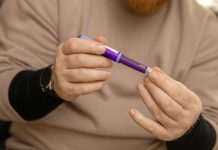
In a new paper, researchers suggest that it is time to put greater investment from governments, health professionals and researchers to reduce costly and common diabetes-related foot disease (DFD).
The team said DFD is Australia’s least recognized chronic health problem.
It costs the health care system about $1.6 billion a year and has mortality rates higher than rates for many cancers.
It is also the leading cause of limb amputation in Australia, with the nation having the second highest diabetes-related amputation rate among OECD countries.
DFD commonly develops from trauma in the presence of peripheral neuropathy or peripheral arterial disease and is complicated by infection.
Neuropathy results in patients losing the ability to feel pain, and consequently not recognize the severity of their DFD and delay seeking treatment.
They estimated that about 50,000 Australians have DFD ulcers, infections and ischemia (restriction of blood supply to tissues) and a further 300,000 have major risk factors for developing DFD.
However, less than 10% of the 540 interdisciplinary DFD services needed to manage the 50,000 Australians with DFD are available.
DFD is a complex condition that is not easily identified, prevented or treated.
It requires a coordinated, interdisciplinary approach that harnesses the complementary skills of medical, surgical, nursing and allied health disciplines across primary, secondary and tertiary care systems.
Recommendations in the strategy on increasing access to care, subsiding evidence-based treatment and implementing national models of interdisciplinary care, are similar to those previously published by other national bodies, the authors say.
The authors call on “Australian health professionals, researchers and governments to finally act” and argue that investment in the strategy “should ensure not only a significant financial return on investment to the health budget but, more importantly, save the limbs and lives of Australians.”
The paper is published in the Medical Journal of Australia.
Copyright © 2018 Knowridge Science Report. All rights reserved.
Source: Queensland University of Technology.



